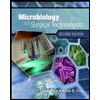
(1)
To determine:
If a diagnosis can be made from this information; and the diagnosis itself
Case summary:
In the given scenario, a 20-year-old soldier who served Iraq reports to his local administrative hospital about a several large painless sores on his head and face. Some of the ulcers had healed leaving scars. A sample taken from a lesion showed the presence of flagellated protozoa under the microscope.
(2)
To determine:
The treatment that the medic should order.
Case summary:
In the given scenario, a 20-year-old soldier who served Iraq reports to his local administrative hospital about a several large painless sores on his head and face. Some of the ulcers had healed leaving scars. A sample taken from a lesion showed the presence of flagellated protozoa under the microscope.
(3)
To determine:
The way in which the soldier became infected.
Case summary:
In the given scenario, a 20-year-old soldier who served Iraq reports to his local administrative hospital about a several large painless sores on his head and face. Some of the ulcers had healed leaving scars. A sample taken from a lesion showed the presence of flagellated protozoa under the microscope.
(4)
To determine:
The preventive measures against this disease.
Case summary:
In the given scenario, a 20-year-old soldier who served Iraq reports to his local administrative hospital about a several large painless sores on his head and face. Some of the ulcers had healed leaving scars. A sample taken from a lesion showed the presence of flagellated protozoa under the microscope.
(5)
To determine:
The reason why the soldier’s body could not fight off the
Case summary:
In the given scenario, a 20-year-old soldier who served Iraq reports to his local administrative hospital about a several large painless sores on his head and face. Some of the ulcers had healed leaving scars. A sample taken from a lesion showed the presence of flagellated protozoa under the microscope.
Want to see the full answer?
Check out a sample textbook solution
Chapter 23 Solutions
Microbiology With Diseases By Taxonomy (6th Edition)
- Amino Acid Coclow TABle 3' Gly Phe Leu (G) (F) (L) 3- Val (V) Arg (R) Ser (S) Ala (A) Lys (K) CAG G Glu Asp (E) (D) Ser (S) CCCAGUCAGUCAGUCAG 0204 C U A G C Asn (N) G 4 A AGU C GU (5) AC C UGA A G5 C CUGACUGACUGACUGAC Thr (T) Met (M) lle £€ (1) U 4 G Tyr Σε (Y) U Cys (C) C A G Trp (W) 3' U C A Leu בוט His Pro (P) ££ (H) Gin (Q) Arg 흐름 (R) (L) Start Stop 8. Transcription and Translation Practice: (Video 10-1 and 10-2) A. Below is the sense strand of a DNA gene. Using the sense strand, create the antisense DNA strand and label the 5' and 3' ends. B. Use the antisense strand that you create in part A as a template to create the mRNA transcript of the gene and label the 5' and 3' ends. C. Translate the mRNA you produced in part B into the polypeptide sequence making sure to follow all the rules of translation. 5'-AGCATGACTAATAGTTGTTGAGCTGTC-3' (sense strand) 4arrow_forwardWhat is the structure and function of Eukaryotic cells, including their organelles? How are Eukaryotic cells different than Prokaryotic cells, in terms of evolution which form of the cell might have came first? How do Eukaryotic cells become malignant (cancerous)?arrow_forwardWhat are the roles of DNA and proteins inside of the cell? What are the building blocks or molecular components of the DNA and proteins? How are proteins produced within the cell? What connection is there between DNA, proteins, and the cell cycle? What is the relationship between DNA, proteins, and Cancer?arrow_forward
- please fill in the empty sports, thank you!arrow_forwardIn one paragraph show how atoms and they're structure are related to the structure of dna and proteins. Talk about what atoms are. what they're made of, why chemical bonding is important to DNA?arrow_forwardWhat are the structure and properties of atoms and chemical bonds (especially how they relate to DNA and proteins).arrow_forward
- The Sentinel Cell: Nature’s Answer to Cancer?arrow_forwardMolecular Biology Question You are working to characterize a novel protein in mice. Analysis shows that high levels of the primary transcript that codes for this protein are found in tissue from the brain, muscle, liver, and pancreas. However, an antibody that recognizes the C-terminal portion of the protein indicates that the protein is present in brain, muscle, and liver, but not in the pancreas. What is the most likely explanation for this result?arrow_forwardMolecular Biology Explain/discuss how “slow stop” and “quick/fast stop” mutants wereused to identify different protein involved in DNA replication in E. coli.arrow_forward
 Comprehensive Medical Assisting: Administrative a...NursingISBN:9781305964792Author:Wilburta Q. Lindh, Carol D. Tamparo, Barbara M. Dahl, Julie Morris, Cindy CorreaPublisher:Cengage Learning
Comprehensive Medical Assisting: Administrative a...NursingISBN:9781305964792Author:Wilburta Q. Lindh, Carol D. Tamparo, Barbara M. Dahl, Julie Morris, Cindy CorreaPublisher:Cengage Learning Microbiology for Surgical Technologists (MindTap ...BiologyISBN:9781111306663Author:Margaret Rodriguez, Paul PricePublisher:Cengage Learning
Microbiology for Surgical Technologists (MindTap ...BiologyISBN:9781111306663Author:Margaret Rodriguez, Paul PricePublisher:Cengage Learning Medical Terminology for Health Professions, Spira...Health & NutritionISBN:9781305634350Author:Ann Ehrlich, Carol L. Schroeder, Laura Ehrlich, Katrina A. SchroederPublisher:Cengage Learning
Medical Terminology for Health Professions, Spira...Health & NutritionISBN:9781305634350Author:Ann Ehrlich, Carol L. Schroeder, Laura Ehrlich, Katrina A. SchroederPublisher:Cengage Learning





